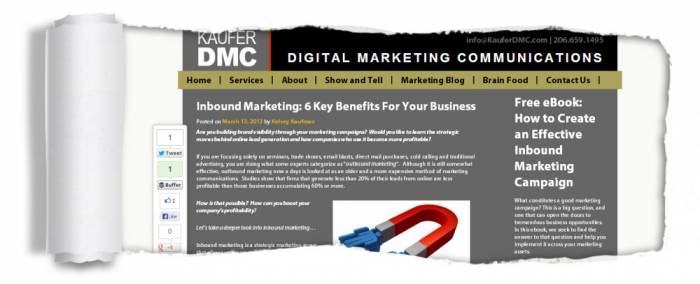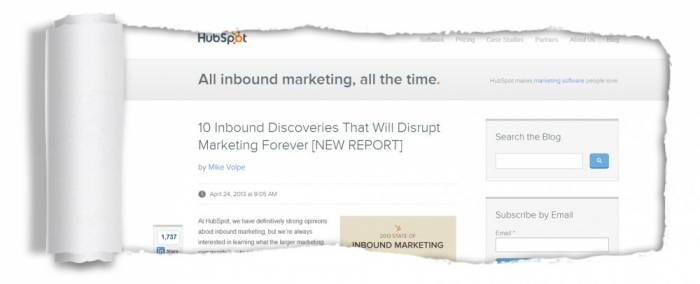
04 Jul Skyrocket Your Growth with Inbound Marketing
Inbound marketing is a fairly debatable term in the world of online marketing and SEO. Nevertheless, what this term represents exists and it is vital as never before. What it stands for is a marketing cycle based on content which enables communication with customers on various levels and presupposes the existence of different stages of the company–consumer relationship. In order to show you how to use inbound marketing to your advantage, we first need to explain it in more detail.
Inbound Marketing Principles
Inbound marketing is a multi-channel, multi-layer way of communicating with customers. First of all, you need to attract strangers and turn them into visitors. There are several “tools” used to achieve this, such as: blogs, social media, landing pages, etc. For these “tools” to be used, a lot of great content is required, which needs to be published at just the right time.
The next step is to turn visitors to leads, to get them really interested in what you have to offer. Landing pages, contact pages, and especially calls-to-action are crucial in this phase.
You would want to turn leads to customers in the next step. To do this, you need to use calls-to-action, e-mails, customer relationship integration management, customer subscriptions, etc.
Happy customers regularly turn into promoters by means of social media, e-mail and smart calls-to-action. Basically, this is the final step of the process in which your marketing efforts give exponentially growing results.
This type of marketing is based on bringing in visitors and serving them with just the right pieces of content at just the right time. The content also needs to be tailored to the stage your audience is in during the interaction process with your company.
Start Harvesting Inbound Marketing Benefits
To use inbound marketing to your benefit, you must first understand that traditional marketing techniques, now known as outbound marketing, do not pay off as much as they used to. People do not want to be bombarded with commercials for products they do not need at the moment, they want to be able to Google what they need and find trustworthy providers of such a product or a service, or simply go to the social network of their choice and see what the word-of-mouth for certain types of products is.
Creating customer personas
Creating customer personas is a crucial part of developing the appropriate content strategy for inbound marketing. Doing this allows you to segment your audience in a way that enables you to respond to specific needs and pains of different groups of your customers, as well as potential customers. Your content needs to resonate with just the right people.
- Make a list of questions about your target audience
According to Hubspot, these are some of the question you need to ask:
- What is their demographic information?
- What is their job and level of seniority?
- What does a day in their life look like?
- What are their pain points?
- What do they value most?
- What are their goals?
- Where do they go for information?
- What experience are they looking for when shopping for your products and services?
- What are their most common objections to your product or service?
These questions will help you identify several types of buyer personas your target audience consists of.
- Gather a team that will help you with customer personas
Your marketing department needs to be included in this, as well as some other creative people who have the ability to think analytically. Your team needs to be able to spot distinct qualities as well as intersections between different customer personas, and to be able to apply what you have learned about your customers to concrete marketing tasks.
- Create a template for each persona you identify
You will inevitably identify several patterns recognizable as customer personas you will then speak to through your marketing efforts. You will probably also find points of intersection between these personas, which you can use to create content which can be used for several customer groups. Buyers persona templates can be easily found around the web, but you need to approach them with caution because each business has distinct characteristics, so the templates will probably need adjustments.
Opening different lines of communication
As we already mentioned, social media is a significant part of inbound marketing. Though other mediums are used, social media seems to be the central ingredient. What you need to do is to:
- Choose social networks according to the customer personas you’ve identified
Different age groups are frequent on different networks. Also, the use of social networks can be gender dependent, or it can depend on the types of products or services you offer.
- Create a presence
You need to establish profiles and pages containing information about the company and services or products on offer, with plenty of images, customer testimonials and examples (create a small portfolio).
- Create the appropriate circles of people or friend groups according to the type of audience you are targeting on the given network
- Listen to what they are talking about
Listen until you are ready to join the conversation. Start a natural interaction, not mentioning your products or services, but trying to be personal and useful.
Create and distribute content
Listening to your target audience can tell you what type of content to create for different audiences. When combined with what you have learned from creating customer personas, it is a powerful means of targeting audiences.
You will need a team capable of creating content which directly corresponds to the needs of your visitors. The content needs to be as specific as possible, providing useful information, help and solutions.
After that, it needs to be properly distributed to the audiences it was meant for.
Benefits of Inbound Marketing
Inbound marketing is way too big a field to explain it completely in one single article. However, the tips we offer are enough to begin with and achieve primary goals. If you are still wondering why inbound marketing should become a part of your strategy, here’s why:
- It is attraction based, so you do not bore your customers.
- Save up to 60% of your marketing budget.
- Become 2X more profitable than outbound marketers.
- Generate a plethora of website impressions.
- Get up to 55% higher conversion rates.
- 41% of marketers confirmed that inbound marketing produces measurable ROI, and a staggering 82% of marketers who blog see positive ROI for their inbound marketing.
- 17% of marketers say both traditional advertising and direct mail have become less important in the past six months.
- 43% of marketers generated a customer via their blog this year, though the blog requires roughly 9% of marketers’ total full-time staff dedications and just 7% of their total budget.
Sources: blog.hubspot.com

These stats and everything we have previously mentioned speak loudly enough. Combine that with the results you are going to achieve, and you will probably become one of the promoters of inbound marketing yourself soon enough.


